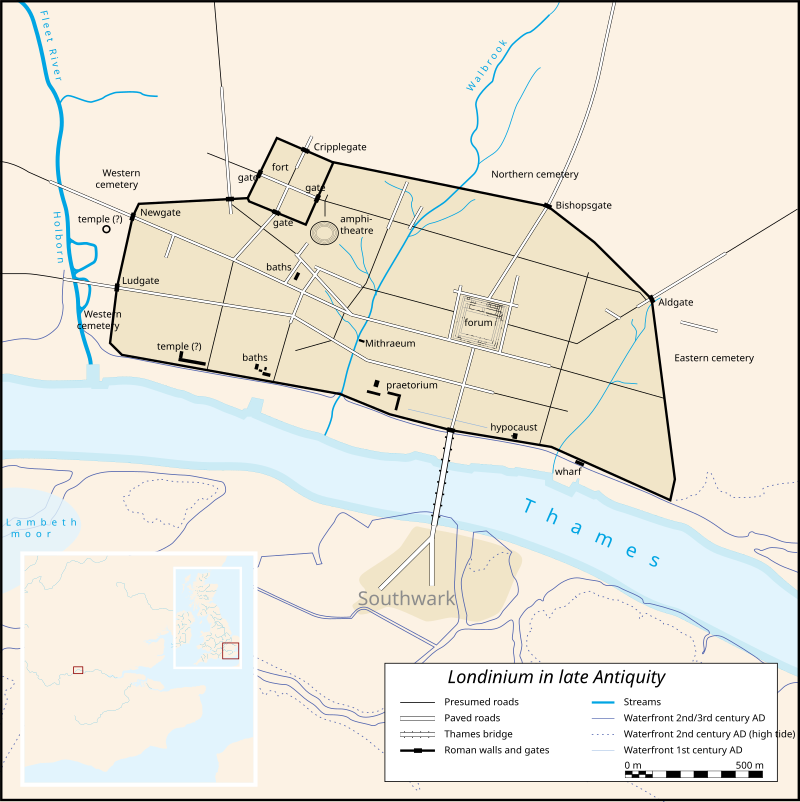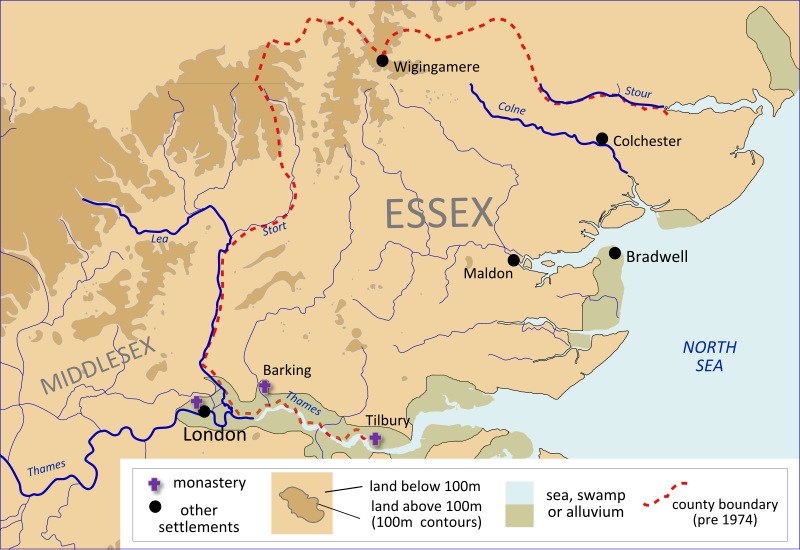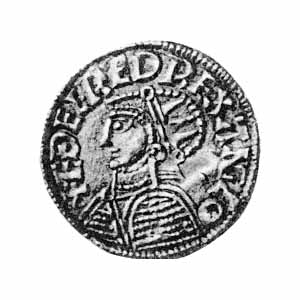
The Rise and Fall of Lundenwic in Anglo-Saxon England
Lundenwic, meaning "London trading town" in Old English, was an Anglo-Saxon settlement that flourished on the north bank of the River Thames from the late 6th to the early 9th century. This settlement, distinct from the old Roman city of Londinium, played a crucial role in the economic and urban development of early medieval London. The rediscovery and study of Lundenwic have significantly altered our understanding of Anglo-Saxon urban life and the continuity of London's importance as a center of trade and commerce.
Historical Context

An anachronistic depiction of Roman London (Londinium) during late Antiquity, spanning from the 2nd to 5th century AD. (Photo: Fremantleboy CC BY 2.5)
The story of Lundenwic begins in the aftermath of Roman withdrawal from Britain in the early 5th century. As Roman urban life declined, the walled city of Londinium was largely abandoned. However, the strategic location of London on the River Thames ensured that the area would not remain uninhabited for long.
The late 6th and early 7th centuries saw the rise of new power structures in Anglo-Saxon England. The kingdom of the East Saxons (Essex) emerged as a significant political entity, with London at its western frontier. It was during this period that Lundenwic began to take shape, representing a new model of urban settlement adapted to the changing economic and political landscape of post-Roman Britain.
The Rise of Lundenwic

A map depicting London and the Kingdom of Essex, which once encompassed Middlesex, Surrey, and Kent (Photo: Hel-hama CC BY-SA 3.0)
Lundenwic emerged as a thriving settlement around 600 CE, located in what is now the Covent Garden and Strand area of modern London. This location, about a mile upstream from the old Roman city, offered several advantages. It provided easy access to the river for trading ships, while also offering space for expansion that the confined area within the old Roman walls could not.
The development of Lundenwic was likely influenced by similar trading settlements or "wics" that were emerging across northwestern Europe during this period. These include Quentovic in northern France, Dorestad in the Netherlands, and Hedeby in Denmark. Such settlements played a crucial role in the revival of long-distance trade in the post-Roman world.
Layout and Urban Structure
Archaeological evidence suggests that Lundenwic was a substantial settlement, covering an area of about 600,000 square meters (60 hectares) at its peak. The town was laid out in a grid pattern, with streets running parallel and perpendicular to the River Thames. This planned layout indicates a level of centralized authority and urban planning that challenges older notions of the "Dark Ages" as a period of complete urban decay.
The settlement consisted primarily of wooden buildings, including houses, workshops, and warehouses. Many of these structures were sunken-featured buildings, a common Anglo-Saxon architectural style. The town also featured larger structures that may have served as public buildings or elite residences.
Economy and Trade

An illustration of a gold coin, likely minted in London during the reign of Æthelred the Unready, featuring the king depicted in armour.
Lundenwic's economy was primarily based on trade and craft production. The settlement acted as a crucial link in long-distance trade networks that connected Anglo-Saxon England with continental Europe and beyond. Archaeological finds from Lundenwic include pottery from the Rhineland, glass vessels from France, and even luxury items from as far away as the eastern Mediterranean.
Craft production was another key aspect of Lundenwic's economy. Excavations have revealed evidence of metalworking, including gold and silver for jewelry production, as well as iron smithing. Bone and antler working, textile production, and pottery making were also significant activities. The diversity and sophistication of these crafts indicate a thriving urban economy.
Decline and Abandonment
The decline of Lundenwic began in the early 9th century, coinciding with an increase in Viking raids on England. The exposed nature of the settlement, lacking the defensive walls of the old Roman city, made it vulnerable to these attacks. Historical records mention a Viking attack on London in 842 CE, which may have been a significant factor in the settlement's decline.
By the late 9th century, the focus of urban life in London had shifted back to the site of the old Roman city. This move was likely part of King Alfred the Great's program of urban fortification against Viking incursions, known as the burghal system. The old Roman walls were repaired and reoccupied, marking the beginning of the medieval City of London and the end of Lundenwic as a distinct settlement.
Archaeological Evidence
The existence of Lundenwic was largely forgotten until the late 20th century. Its rediscovery is a triumph of modern archaeology and a testament to the value of urban archaeology in uncovering lost chapters of history.
An axe discovered near London Bridge (Photo: The Viking Age Compendium)
Key archaeological investigations include excavations at the Royal Opera House site in the 1990s, which revealed extensive evidence of Anglo-Saxon occupation. Other significant sites include the National Gallery extension, Jubilee Hall, and various locations along the Strand. These excavations have yielded a wealth of artifacts, including pottery, metalwork, and organic materials, providing insights into daily life, trade connections, and craft activities in Anglo-Saxon London.
Significance in Anglo-Saxon History
The study of Lundenwic has significantly altered our understanding of urban life in Anglo-Saxon England. It demonstrates that the period between the end of Roman rule and the Viking age was not simply one of urban decay, but rather saw the development of new forms of urban settlement adapted to changing economic conditions.
Lundenwic also provides evidence for the continuity of London's importance as a center of trade and commerce. Despite the abandonment of the Roman city, the London area continued to play a crucial role in long-distance trade networks, linking Anglo-Saxon England with continental Europe and beyond.
Furthermore, the planned layout and diverse economic activities of Lundenwic challenge simplistic notions of the "Dark Ages." They reveal a society capable of complex urban planning and participating in sophisticated international trade networks.
Conclusion
Lundenwic represents a crucial chapter in the long history of London. Its rise, flourishing, and eventual abandonment illuminate the complex processes of urban development and change in early medieval Europe. The settlement's existence demonstrates the resilience and adaptability of urban life in the face of significant political and economic changes.
The story of Lundenwic also underscores the importance of archaeology in uncovering and interpreting the past. Without modern archaeological techniques and urban excavations, this significant phase in London's history might have remained hidden.
As research continues, our understanding of Lundenwic and its place in Anglo-Saxon England continues to evolve. This lost trading town serves as a reminder of the dynamic and interconnected nature of early medieval society, challenging us to reconsider our perceptions of the past and the enduring importance of London as a center of trade and urban life.





